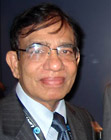
DIABETES MELLITUS
The scourge of Indians - Part 1

During a casual conversation, an Indian friend of mine mentioned that he was feeling tired towards the end of the day. Physically active and of normal build, he didn’t have any vices and had felt good till now.
“Why don’t you check your fasting and random blood sugar?” I suggested.
The next day, he called me and said, “You know what, my blood sugars are high, looks like I have diabetes!”
So, at the young age of 39, he has developed Diabetes Mellitus!
I hear these type of stories often enough and they are becoming increasingly common among Indians. The reason? Diabetes Mellitus, Type 2 (DM 2) has become a common disease globally and the incidence is going up in developing countries. We, Indians, are especially susceptible along with African Americans, Native Americans and Hispanics. In the United States, 26 million suffers from the disease and another 79 million are pre-diabetic.
The world diabetic population is also exploding. In 2007, the number was about 246 million and the most recent estimates suggest it has more than doubled affecting almost 10 percent of the population! And guess who leads the pack? India, of course! The estimate of the actual number of diabetics in India is around 40 million. Which means India actually has the highest number of diabetics in any one country. China is in second place followed by the U.S.
Sadly, almost a quarter of the diabetics don’t even know they have the disease. And they can live for years without being treated, which means, severe damage can be done in the meanwhile to their vital organs. In addition to heart disease and stroke, this can also escalate into blindness, kidney failure, loss of limbs and even death.
And what about the costs? As per the American Diabetes Association, the total costs of diagnosed diabetes alone have risen to $245 billion in 2012 from $174 billion in 2007, a 41 percent increase over a five year period! Sadly, there is no end in sight – a frightening prospect.
What is Diabetes?
All of you know DM is a disease in which ‘sugar’ plays a key role. It is characterized by elevated blood sugar in the blood that results from either inadequate production of the hormone insulin by the beta cells in the pancreas or resistance of the body tissues to its action -- called insulin resistance. Insulin is absolutely necessary for the body to utilize the glucose in the blood that is absorbed from the food. All the complex carbohydrates that you ingest are broken down into glucose by the digestive system and transported to the cells to be metabolized by insulin and utilized by tissues for energy.
There are two types of DM. Type 1 is an autoimmune disease that damages the pancreatic beta cells. It is more prevalent in children and young adults and the reasons are not clear. In Type 2, either the body does not produce enough insulin or the cells are unable to utilize the insulin produced. Also called “adult onset diabetes,” this is the commonest type and accounts for nearly 90 percent of the disease that we see around us.
Pre-diabetes is a condition that predisposes one to the development of diabetes in later life, usually within 10 years after recognition, unless preventive steps are taken. Here, the person's blood glucose levels are higher than normal but not high enough for a diagnosis of DM 2. According to many experts, prediabetes has become America's largest healthcare epidemic. Certainly it is true for people of Indian origin, so much so, some diabetologists think that most Indians are either prediabetic or diabetic. Although prediabetes has no symptoms, it is not benign; many are at high risk for heart disease and stroke.
A common misconception among diabetics is, “Oh it is just a matter of controlling the blood sugar and everything will be okay.” Not quite; DM 2 is a complex disease that affects literally every organ in your body and, is often associated with many other problems as well. Hence, it needs a comprehensive approach. DM 2 patients have up to four times increased risk of heart disease compared to those without and, hence it is considered a “coronary heart disease equivalent” by American College of Cardiology.
To be continued . . .
Dr. M. P. Ravindra Nathan is a Brooksville cardiologist.